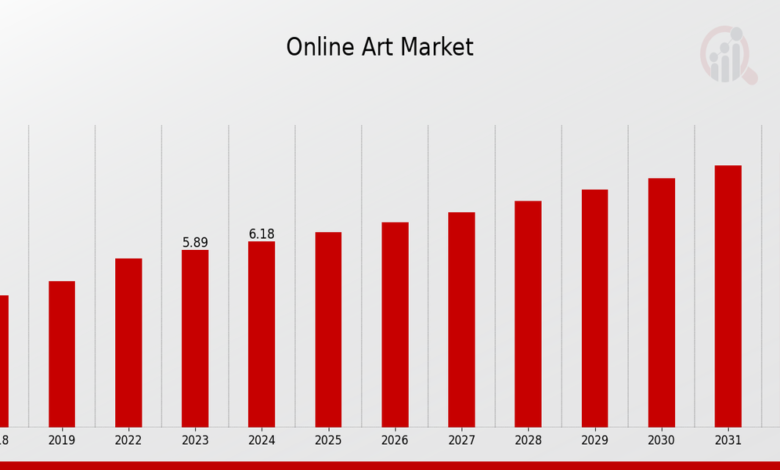
Online Art Market Overview:
The Online Art Market has experienced significant growth over the past decade, driven by technological advancements and changing consumer behaviors. As of 2023, the global online art market is estimated to be worth several billion dollars, reflecting a shift from traditional galleries to digital platforms. This transformation has been accelerated by the COVID-19 pandemic, which forced many artists and galleries to adapt to online sales channels. The convenience of browsing and purchasing art from home has attracted a broader audience, including younger collectors who are more comfortable with digital transactions. Online art marketplaces have become essential for artists seeking exposure and for buyers looking for unique pieces without geographical limitations.
Market Key Players:
Several key players dominate the online art market, each offering unique platforms that cater to different segments of buyers and sellers. Major online marketplaces include Artsy, Saatchi Art, and Artnet, which provide extensive catalogs of artworks from various artists around the world. Auction houses like Sotheby’s and Christie’s have also embraced online bidding platforms, allowing them to reach a global audience while maintaining their prestigious reputation. Additionally, social media platforms such as Instagram have emerged as vital tools for artists to showcase their work and connect directly with potential buyers. These key players contribute significantly to shaping market trends and consumer preferences in the online art space.
[PDF Brochure] Request for Sample Report:
https://www.marketresearchfuture.com/sample_request/26698
Market Segmentation:
The online art market can be segmented based on various criteria such as type of artwork, price range, and buyer demographics. In terms of artwork type, segments include paintings, sculptures, photography, prints, and digital art. Each category appeals to different audiences; for instance, contemporary art often attracts younger collectors while classical pieces may appeal more to seasoned investors. Price range segmentation reveals distinct markets; affordable art under $1,000 caters to emerging collectors whereas high-end artworks priced above $10,000 attract affluent buyers seeking investment opportunities. Additionally, demographic segmentation highlights differences in purchasing behavior among millennials versus older generations; millennials tend to favor digital-first experiences while older generations may still value traditional gallery visits.
Market Opportunities:
The online art market presents numerous opportunities for growth and innovation. One significant opportunity lies in expanding access to underrepresented artists from diverse backgrounds who may not have had traditional gallery representation. Platforms that prioritize inclusivity can tap into new customer bases eager for fresh perspectives in the art world. Furthermore, advancements in technology such as virtual reality (VR) and augmented reality (AR) offer innovative ways for consumers to experience artworks before purchasing them—allowing potential buyers to visualize how a piece would look in their own space. The rise of non-fungible tokens (NFTs) also represents a burgeoning segment within the online art market that could redefine ownership and provenance in digital artworks.
Market Drivers:
Several factors drive the growth of the online art market today. Firstly, increased internet penetration globally enables more people to access online platforms where they can discover and purchase artwork easily. Secondly, changing consumer attitudes towards collecting—particularly among younger generations—have led to a greater appreciation for unique pieces over mass-produced decor items. Additionally, social media’s role in promoting artists has created an environment where word-of-mouth marketing thrives; this organic promotion helps build trust between creators and consumers. Lastly, economic factors such as rising disposable incomes among certain demographics allow more individuals to invest in art as both a personal passion and an asset class.
Regional Analysis:
Regionally speaking, North America remains one of the largest markets for online art sales due primarily to its established infrastructure supporting e-commerce activities along with a strong culture surrounding collecting fine arts. Europe follows closely behind with countries like the UK leading in both supply (artists) and demand (collectors). Asia-Pacific is emerging rapidly as an important player thanks largely due its growing middle class interested in investing in cultural assets; China specifically shows promise with increasing numbers of young collectors entering this space through mobile-first platforms tailored specifically for them.
Recent Development:
Recent developments within the online art market include heightened interest in NFTs following their explosive popularity starting around 2020-2021; many traditional galleries now feature NFT exhibitions alongside physical works showcasing how digital assets can coexist within established frameworks of artistic expression. Additionally, collaborations between tech companies specializing in blockchain technology aim at enhancing transparency regarding provenance—a critical concern when buying high-value artworks—thus fostering greater confidence among buyers navigating this evolving landscape.
Browse In-depth Market Research Report:
https://www.marketresearchfuture.com/reports/online-art-market-26698
Contact Us:
Market Research Future (Part of Wantstats Research and Media Private Limited)
99 Hudson Street, 5Th Floor
New York, NY 10013
United States of America
+1 628 258 0071 (US)
+44 2035 002 764 (UK)
Email: sales@marketresearchfuture.com



